Learn about Wifi AD, speeds up to 4.6 Gbps, potentially replacing cables
It delivers top speed for home Wifi, but at high prices and with little support, is its performance worth investing?
There is already a new Wifi standard, which helps to push the network speed to a new level.802.11ad standard WiFi has data rates of up to 4,600 Mbps, which is four times faster than current speed standards, 802.11ac . It is much faster than the Gigabit Ethernet (1 Gbps) standard and most of the household broadband speed. Even if you want to watch movies online with HDR images, 4K resolution via Wifi, that's not a problem with 802.11ad, even though many Wi-Fi users already know, there's still a big difference between speed. theory and reality.
The first home-based routers equipped with this new Wi-Fi standard are the Netgear Nighthawk X10 and the TP-Link Talon AD7200. Along with completely new technology, these routers are also not cheap, with the AD7200 likely to make you "hurt" at a price of 360 USD. But is it worth the peak price?
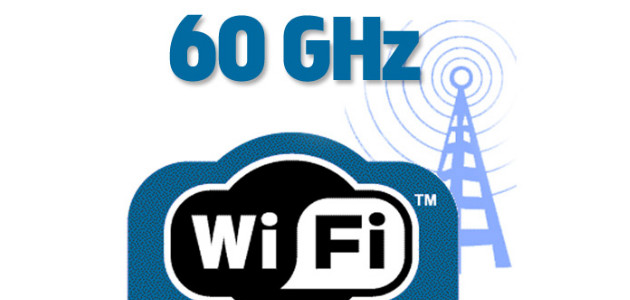
How does 802.11ad standard WiFi work?
Like previous versions of Wifi, 802.11ad standard is officially approved by the Wifi Alliance . However, unlike previous versions, the technology of this standard does not come from IEEE (Electrical and Electronics Engineering Institute). Instead, it is based on technology created by the WiGig Alliance (Wireless Gigabit). The technology was officially announced in 2009, beginning the draft phase with IEEE in 2011 and eventually emerged as a standard today when the WiGig Alliance merged with the Wifi Alliance in 2013.
The important thing is that this new standard uses a completely different frequency range than previous Wi-Fi standards. Instead of using the 2.4 GHz or 5GHz frequency as the 802.11b / g / n / ac standards, it operates on a frequency of 60GHz (ranging from 57 to 66 GHz, depending on where you live). The frequency region around 60GHz means more data is transmitted, but it also has drawbacks.
The biggest problem is: higher frequencies mean shorter wavelengths , which also lead to a larger rate of decline. This does not matter if in a vacuum, but in the real world, with countless walls of wood and bricks around us, high frequency waves mean that it will be more difficult to transmit distances. far. That is why, long-wavelength signals like radio waves and television can travel at great distances while shortwave is the opposite.
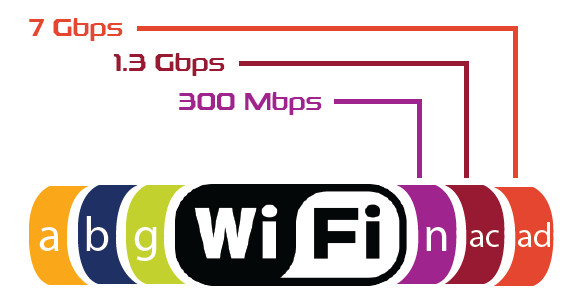
With Wifi, all their frequencies are microwave, ranging from 300MHz to 300GHz, with wavelengths ranging from about 1m to 1mm. Whereas, the 2.4GHz frequency of old Wifi standards such as a / b / g is low enough to have good penetration and is easily transmitted through human bodies, doors and walls. At 5GHz, the range is only suitable in a small house.
Even so, with the 802.11ad standard, the signal cannot even penetrate a single wall and is significantly degraded when encountering a wooden wall. As a result, even if 802.11ad delivers very high speeds if you are in the same room as the router, but when stepping outside the room, or even just leaving the router out of sight, you may lose signal. .
That's why 802.11ad is not a replacement for existing Wifi standards. Instead, like the 5GHz routers that still support 2.4GHz, 802.11ad-standard 60GHz routers still support older standards so they can be used at a distance.
Replace the cable
However, 802.11ad may be a viable alternative to cables, and in fact, that was the original purpose of WiGig. With products like TVs, set-top boxes, smartphones and even 4K resolution wireless cameras, or NAS devices and portable hard drives in the same room, 802.11ad can remove complex wiring between these devices.
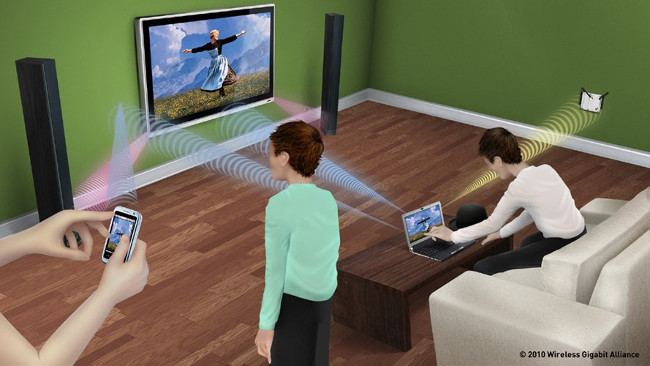
This can also expand into an office environment with wireless laptops and connected screens will benefit from this technology. Dell was one of the early adopters of WiGig in 2013, when they created the Dell Wireless Dock D5000 wireless connector, allowing users to stream videos from a Latitude laptop to this dock and to screens using HDMI.
Equipment equipped with 802.11ad
As mentioned above, currently only 2 routers show that it is equipped with 802.11ad, but the Netgear Nighthawk X10 has not yet appeared. However, Amazon is still listing it at $ 624, with clear parameters for the high-end segment. Besides 802.11ad, it also has 6 Gigabit Ethernet ports combined with dual-gigabit paths, a quad-core processor of 1.7GHz (apparently ARM platform), two USB 3.0 ports for sharing printers and files. It is also the first router to support Plex server port.
Meanwhile, the TP-Link Talon AD7200 has a slightly more limited approach, with only 4 Gigabit Ethernet ports, a 1.4 GHz quad-core processor and a basic USB port, a modest choice. compared to the opponent above. However, it still has a high price, £ 380 (about 474 USD).
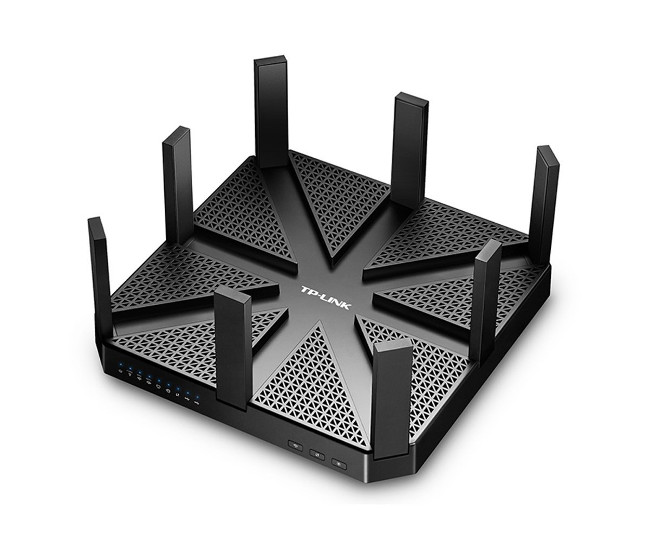 The TP-Link Talon AD7200.
The TP-Link Talon AD7200.
This price is even higher when considering the time of this article, no household device can connect to this router through the 802.11ad standard. If so, perhaps only the mid-range Travelmate P648 Acer laptop was released earlier this year. Perhaps, it takes at least another 6 months before this situation changes.
So perhaps the most obvious reason for you to buy a router of this type is if you want to wirelessly connect two routers to extend your coverage. You will connect the network between two offices right next to each other or bring Wifi to anywhere in your house without wires.
So 802.11ad has been inflated?
While the 802.11ad standard is still unpopular, its performance is worth your investment.
To test this standard, Arstechnica tried to install the TP-Link Talon AD7200 and connected to a laptop with an external PCIe 802.11ad card, also provided by TP-Link, to run the LAN Speed test. This test will load an application on the host device and transmit the data straight from the memory to the network, in order to remove the bottleneck of storage. To do so, they use a second laptop as a test server, connecting to the TP-Link router via one of the Gigabit Ethernet ports.
Using this setting, they recorded a maximum download speed of 868 Mbps or 108.5 MB / s. It seems that this parameter is far below the theoretical speed of 4,600 Mbps, but it is still nearly twice the fastest speed of standard WiFi ac they have tested.
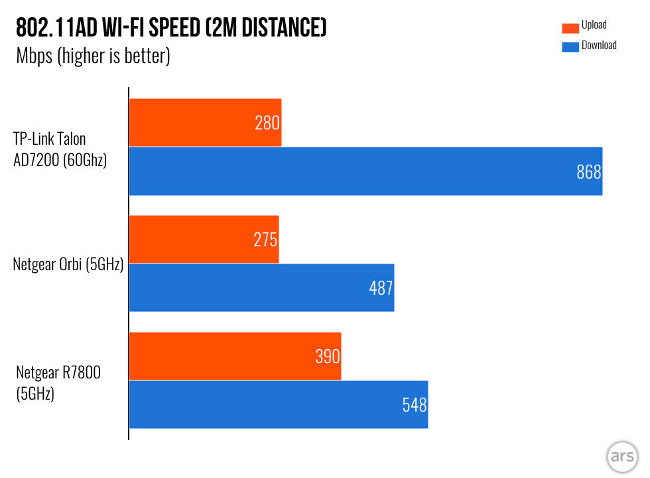 Test results of 802.11ad Wifi on TP-Link Talon AD7200.
Test results of 802.11ad Wifi on TP-Link Talon AD7200.
Moreover, there is also the possibility of a Gigabit Ethernet port in the second laptop that limits the speed. So it is possible that the Netgear X10 will deliver even more speed, as its Gigabit Ethernet port is dual-channel integrated, which is equivalent to using two Ethernet ports at the same time to double the connection speed.
However, besides the potential for high speed, its disadvantages also manifest very clearly. While the maximum range of a family's open space can be up to 10m or shorter, but just standing behind a wooden door, the signal is almost gone. If one step further behind the door frame, the signal will disappear, even though the distance from the router is less than 4m.
While not many devices are equipped with this new technology standard, the strange experience of the test results shows that, perhaps when it becomes popular, device users and manufacturers will have to use 802.11. ad in a completely different way.
Smart connection
While the short range of 802.11ad has inherent problems, there is a way for the router to fix this problem. When you go out of coverage, your device will automatically switch to a longer wavelength range. Routers have such capabilities, often called " band-steering, " or more commonly referred to as the " Smart Connect " feature.
The router equipped with this feature will only need a Wifi SSID name for users to connect, instead of splitting into multiple SSIDs for each band, and it can automatically determine which bandwidth will be used to communicate with the device. affected, based on signal strength, compatibility and frequency band.
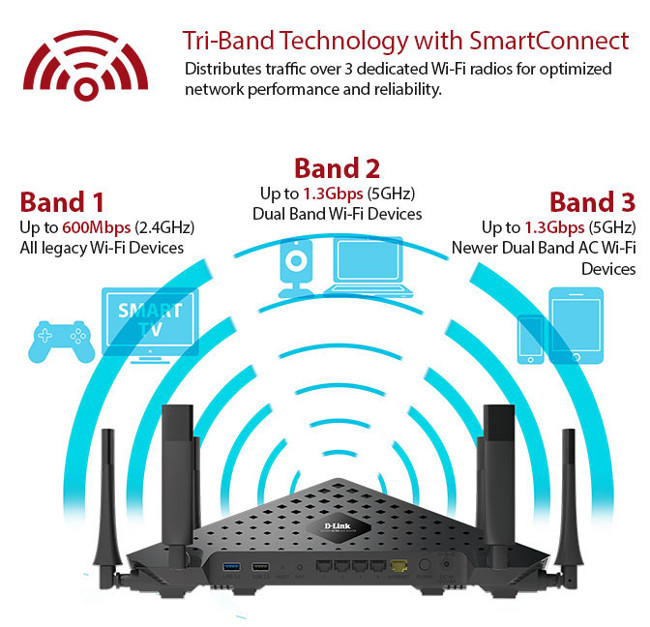 SmartConnect - feature not available on the TP-Link Talon AD7200 .
SmartConnect - feature not available on the TP-Link Talon AD7200 .
However, the TP-Link Talon AD7200 does not have this " band-steering " feature, so you will have to install 2 to 3 SSID Wifi when moving from near to far signal areas. It is possible that this feature will be provided when the AD7200 is updated to future firmware, but it is unclear.
This inconvenience will be a crucial weakness of TP-Link router, when this Wi-Fi standard becomes more popular when many other vendors enter the market. Not only that, this inconvenience will also limit the potential of the AD7200 right now, when users will find it less comfortable with the limitations of this router, and they tend to wait until there are many finishing options. more appeared.
Will 802.11ad be the final limit?
So if 802.11ad is not yet a final standard for Wi-Fi in the near future, but in the longer term?
There are currently some modified versions with 802.11ac and 802.11ad that will appear in the next 3 years or so. The first is 802.11ax, using 2.4 GHz and 5 GHz frequency bands and supporting 1024QAM signal processing mode as well as OFDMA, to make the overall speed significantly faster. Although the test speed is up to 10 Gbit / s, however, only the data lab can afford it, and it wasn't until 2019 that the standard officially came out.
There is also 802.11ay, an extended version of 802.11ad. This standard adds channel links and MU-MIMO (technology that connects multiple input and output points) to increase traffic to 20-40 Gbit / s while coverage is extended to 300-500m. This upgrade will come in 2017, so it is also possible that second generation 60 GHz routers will also appear at this time next year.
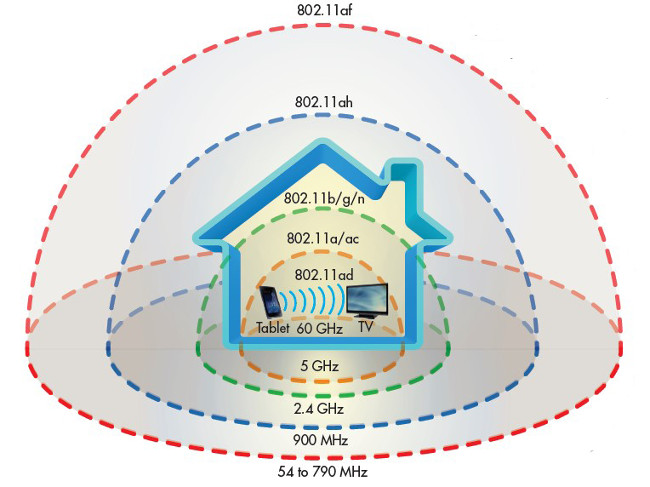
But the coverage limit has had a big impact on not offering higher frequency standards. However, some research is creating faster Wi-Fi when they use a completely different frequency region: visible light. Called "Li-Fi" it is similar to optical cable, but is transmitted in every direction of the light bulb.The range of coverage is still a problem with this standard, since it is always necessary to maintain the visible direction, in addition it consumes a large amount of energy and is disturbed by other light sources.
Meanwhile, there are other standards that prioritize lower frequencies to increase coverage. Like the 802.11ah standard, the 1GHz band has coverage of up to 1 km and low power consumption, but only has data rates of about 150 Kbps. At this rate, this standard is ideal for connecting to IoT devices, which only require simple Internet connections.
Similarly, the 802.11af standard - also known as Super Wifi or white-space Wifi - with a lower frequency, stays between 54 MHz and 790 MHz, allowing it to travel very long distances. However, it has little effect when used at home, because its frequency range passes licensed TV communication, and it requires GPS position confirmation to authenticate the frequency at which the device used.
Currently, 802.11ad is still the pinnacle of home Wi-Fi technology, but you will probably have to wait a bit longer until this standard becomes more popular and the price is much lower.
You should read it
- What is WiFi 6E? How is WiFi 6E different from WiFi 6?
- The new WPA3 WiFi standard was officially released
- New 6E wifi standard, better signal, stronger connection
- Difference between WiFi 5, WiFi 6 and WiFi 6E
- 6 Wifi boosters, amplify the best Wifi wave 2020
- What is WiFi 6? What is WiFi 6E? Things you need to know about WiFi 6 and WiFi 6E
- How to check who is using Wifi temple, your home WiFi theft
- What is Wifi? How does Wifi work?
May be interested
- How to use the old router to increase the coverage for Wi-Fi
 did you know that if you use an old router that is redundant and turn it into an access point (ac), can you increase the coverage for wi-fi to far corners of the house?
did you know that if you use an old router that is redundant and turn it into an access point (ac), can you increase the coverage for wi-fi to far corners of the house? - Unlock WEP Wifi password with Backtrack
 you know that if you want to lock the wifi network, you need to select the wpa key because wep is easily cracked. but do you know how easy it is to unlock wep? in this article, we will gradually learn how to unlock the wifi network using wep security.
you know that if you want to lock the wifi network, you need to select the wpa key because wep is easily cracked. but do you know how easy it is to unlock wep? in this article, we will gradually learn how to unlock the wifi network using wep security. - Free access to WiFi across the country
 currently there are many locations across the country that have free wifi coverage. users can fully access these locations, login to wifi via the provided password.
currently there are many locations across the country that have free wifi coverage. users can fully access these locations, login to wifi via the provided password. - Speed up Internet connection on Windows 10 computers
 internet acceleration helps to get rid of slow network connection. if you're using windows 10, please refer to the following ways to speed up internet connection.
internet acceleration helps to get rid of slow network connection. if you're using windows 10, please refer to the following ways to speed up internet connection. - Instructions for using your phone as a Wi-Fi hotspot
 previously, it was hard to turn your phone into a wi-fi hotspot but now it's a lot simpler. follow the article to see how to do it in detail!
previously, it was hard to turn your phone into a wi-fi hotspot but now it's a lot simpler. follow the article to see how to do it in detail! - Create a wireless connection between two laptops
 for computer users, there will be times when you need to share a file or connect two laptops together to share internet connection. understanding the user's psychology, windows vista and windows 7 have been integrated by microsoft to create a wireless connection between two laptops.
for computer users, there will be times when you need to share a file or connect two laptops together to share internet connection. understanding the user's psychology, windows vista and windows 7 have been integrated by microsoft to create a wireless connection between two laptops.






 New generation Wifi can reach speeds up to 10 Gbps
New generation Wifi can reach speeds up to 10 Gbps Huawei sets a record for 5G network speed with download speeds of up to 3.67 Gbps
Huawei sets a record for 5G network speed with download speeds of up to 3.67 Gbps Which phones support Wifi 6?
Which phones support Wifi 6? Distinguish common types of computer cables
Distinguish common types of computer cables Learn about WiGig, the new super fast WiFi standard
Learn about WiGig, the new super fast WiFi standard